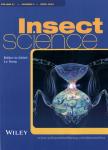Comparative assessment of the thermal tolerance of spotted stemborer, Chilo partellus (Lepidoptera: Crambidae) and its larval parasitoid, Cotesia sesamiae (Hymenoptera: Braconidae)
Comparative assessment of the thermal tolerance of spotted stemborer, Chilo partellus (Lepidoptera: Crambidae) and its larval parasitoid, Cotesia sesamiae (Hymenoptera: Braconidae)作者机构:Department of Biological Sciences and Biotechnology Botswana International University of Science and Technology (BIUST) Private Bag 16 Palapye Botswana Agricultural Research Council Plant Protection Research Weeds Division Private Bag X6006 Hilton 3245 South Africa
出 版 物:《Insect Science》 (昆虫科学(英文版))
年 卷 期:2018年第25卷第5期
页 面:847-860页
核心收录:
学科分类:0710[理学-生物学] 07[理学] 09[农学] 0904[农学-植物保护] 090402[农学-农业昆虫与害虫防治]
基 金:ARC-PPR International Centre for Insect Physiology and Ecology Plant Protection Research Agricultural Research Council, ARC Botswana International University of Science and Technology, BIUST Ministry of Agriculture of the People's Republic of China, MOA South African Sugarcane Research Institute, SASRI
主 题:chill-coma recovery time climate change critical thermal limits heat knock-down time lethal temperatures supercooling point
摘 要:Under stressful thermal environments, insects adjust their behavior and physi- ology to maintain key life-history activities and improve survival. For interacting species, mutual or antagonistic, thermal stress may affect the participants in differing ways, which may then affect the outcome of the ecological relationship. In agroecosystems, this may be the fate of relationships between insect pests and their antagonistic parasitoids un- der acute and chronic thermal variability. Against this background, we investigated the thermal tolerance of different developmental stages of Chilo partellus Swinhoe (Lepi- doptera: Crambidae) and its larval parasitoid, Cotesia sesamiae Cameron (Hymenoptera: Braconidae) using both dynamic and static protocols. When exposed for 2 h to a static temperature, lower lethal temperatures ranged from -9 to 6 ℃, -14 to -2 ℃, and -1 to 4 ℃ while upper lethal temperatures ranged from 37 to 48 ℃, 41 to 49 ℃, and 36 to 39 ℃ for C partellus eggs, larvae, and C. sesamiae adults, respectively. Faster heating rates improved critical thermal maxima (CTmax) in C partellus larvae and adult C partel- lus and C sesamiae. Lower cooling rates improved critical thermal minima (CTmin) in C partellus and C. sesamiae adults while compromising CTmin in C. partellus larvae. The mean supercooling points (SCPs) for C. partellus larvae, pupae, and adults were -11.82 ± 1.78, -10.43 ±1.73 and -15.75 ±2.47, respectively. Heat knock-down time (HKDT) and chill-coma recovery time (CCRT) varied significantly between C partellus larvae and adults. Larvae had higher HKDT than adults, while the latter recovered significantly faster following chill-coma. Current results suggest developmental stage differences in C partellus thermal tolerance (with respect to lethal temperatures and critical thermal limits) and a compromised temperature tolerance of parasitoid C. sesamiae relative to its host, suggesting potential asynchrony between host-parasitoid population phenology and con



